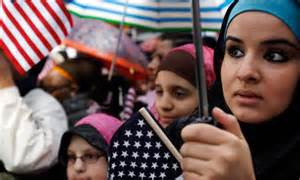Crescent International Monthly, Toronto, Canada, January, 2015
A second-generation Muslim American scholar recounts official treatment of Muslims as “outsiders.” The book makes fascinating reading.
Staff writer Ayesha Alam reviews Zareena Grewal’s new book, Islam Is a Foreign Country: American Muslims and the Global Crisis of Authority (Hbk: $76.50, Pbk: $22.50; 410 pages; New York University Press, New York, 2014).
Zareena Grewal’s book, Islam is a Foreign Country: American Muslims and the Global Crisis of Authority, stands at the intersection of anthropology, media studies, religious studies, Islamic studies and American studies. The global scope of the book’s scholarship is no accident: Grewal is Assistant Professor of American Studies, Religious Studies, and Middle East Studies at Yale University.
She is also the Director for the Study of American Muslims at the Institute for Social Policy and Understanding. Islam is a Foreign Country is the product of ten years of research, a labor of thought and love that aims to convey an “account of American Muslims and their intellectual and spiritual journeys,” as Elliott Bazano noted in a review.
Grewal undertakes an anthropological look at young American Muslims traveling abroad in their search for classical knowledge in Arabic and Islamic sciences, following in the wake of American Muslim figures such as el-Haj Malik el-Shabazz (better known as Malcolm X), Hamza Yusuf and others. Grewal seeks to understand American Islam as a lived experience, a diverse, multinational discourse, and a form of social revival shaped by young African American and second-generation immigrant Muslims undertaking their spiritual rihlahs to places such as Cairo, Damascus and Amman.
The author wishes to question the“foreignness” of Islam, using the term “moral geography” in order to question the binary construction of Islam versus the West. In her introduction, she notes that Americans have inherited the centuries old discourse of orientalism; when referring to the “Muslim World,” they “reproduce, amend, and complicate Colonial Europe’s moral geography of the Orient.” “Where does that leave the American Muslims who are the focus of this book?” she asks, “Do places like Dearborn make the United States part of the ‘Muslim world’?”
The fact that Grewal incorporates ethnography as part of her project’s methodology makes Islam is a Foreign Country engaging and humorous, while also academic. She cites Donald Pease in observing that “a nation is not only a piece of land but a people’s relation to the land.” In order to capture American Muslims’ relation to the United States, she weaves together stories taken from interviews with some of the student-travelers the book focuses on.
She also cites her own experiences as one such student-traveler, whose chapter as an American Muslim began after her family moved to Dearborn, Michigan from Pakistan. Islam is a Foreign Country begins with Dearborn, weaving together social and personal experiences of marginalization. She notes the vibrancy of Dearborn’s famed Arab community, but also the hostility and fear that Americans regard such dense a concentration of Arabs and Muslims living in one area. Like vibrant ethnic enclaves such as Chinatown and Little Italy, Dearborn embodies “the moral geography of the US as a Nation of Immigrants and Land of Opportunity.”However, the Islamophobia it evokes is part of the “crisis of authority” that Islam is facing in the US; she poignantly describes how she drives through the neighborhood and witnesses some Iraqi youths rambunctiously celebrating a soccer victory; they are then promptly approached by a police officer who suspects them of rioting. “Sometimes you are on the map but you are really nowhere,” she writes, citing W.E.B. Dubois from The Souls of Black Folk,“Nowhere is a place American Muslims, like me, have navigated all our lives.”
Grewal takes a unique approach on“American Islam” by emphasizing its globality — the stories of American student travelers, many of them converts to Islam, challenge parochialism and intolerance by erasing the boundaries between “home” and “foreign.” She takes “native informants” such as Irshad Manji sharply to task for perpetuating Bernard Lewis’ toxic formulation of a“clash of civilizations.” Rather, the point is that these students’ earnest, almost romantic, journeys to seek the spiritual heart of Islam, helps define and strengthen the plurality of the United States. We meet students such as Richard, a white American convert to Islam, who is studying calligraphy from a shaykh in Amman; Umar, an African American convert and student at Harvard, seeking training in the religious sciences in al-Azhar; Fawzia, a Bangladeshi American, whose love for the writings of Imam al-Ghazali led her on a quest for spiritual and esoteric knowledge to historic the masjid complex of Damascus (presumably before the civil war and ISIS fiasco). Grewal also discusses the challenges faced by women seekers of ‘ilm in the Muslim world; and also textures the experiences and attitudes of the current Arab world, deeply steeped in “azmatology” (the sense of Islam and Muslims being pervaded in azma or crisis).
The itinerant American student-travelers expose the central fault line in Islam’s current crisis of authority, as she sees it: the transfer of knowledge through unofficial channels outside the regimentalized, highly formal knowledge-system developed by Sunni Islam. “The contemporary sense of crisis among devout Muslims in the US and around the world emerges from the fear that the answer — that is, those bodies of traditional knowledge — is either an inaccessible or inadequate answer to the challenges that devout Muslims face today,” she writes. New faces of authority in Islam include converts who have studied classical Islamic studies, including Hamza Yusuf and Zaid Shakir; second generation American Muslims searching for a spiritual revival; and also televangelists in the Muslim world such as Egypt’s Amr Khaled. Grewal sketches the roots of the African American Islam through the Moorish Science Temple, the Nation of Islam, and Malcolm X. This “shift in authority” has inspired a new generation of student-scholars, traveling from the US to the Muslim world, in order to define themselves.
Islam is a Foreign Country is a well-executed book, a solid contribution to the genre of American Muslim literature (the catalogues compiled by ISNA and the MSA). Indeed, she gave a well-attended book talk at the 2014 ISNA Conference. One criticism is that her focus is mainly on Sunni Islam, ignoring American Shi‘ism and other important Islamic communities. It could also be argued that the book captures the second generation immigrant experience most effectively (not surprising given that this is Grewal’s own background) compared to the experience of African American Islam, which is more complex.
The book is written mostly for a non-Muslim audience, so for Muslims, information such as her background on the Prophet Muhammad (pbuh) and the biographical portraits of Mark Hanson (aka Hamza Yusuf) and Malcolm X can seem a little dated. While she tangentially refers to post-9/11 Islamophobia, Grewal could have explored further the impact that the fear-mongering of Islam in the mainstream US media has on such spiritual and personal journeys. Likewise, it is clear that the research material is before the “Arab Spring,” ISIS and the region’s fall into sectarian violence and authoritarian control; the Muslim East seems to be a different place than the spaces she captures in her book. However, the book’s strength is in the ethnography, her portraits of young Muslim American scholars narrating their rihlahs in their own voices; and in portraying the warm, palpable sense of lived Islam in its social complexity. Islam is a Foreign Country is a must-read.
 Mouood Mouood English Edition
Mouood Mouood English Edition




